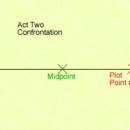
How to write a script for submission? Some important tips.
Experienced screenwriters know that every script has two versions:
1. The draft with which you raised money and got approval for production
2. The final draft for filming
These two drafts are different, and not just because in the filming draft, producers, directors, cinematographers, and actors have entered with their own passions and desires. They’re also different because the purpose of the two scripts is different.
The final draft for filming is a detailed plan for making the film that the director and the heads of the various departments (heads = heads of the technical departments of photography, sound, art, etc.) will know as much as possible what they need to prepare for the production itself.
The draft that is submitted to funds, broadcasting bodies, investors, and producers has a different and unique purpose: that the script will be approved for production. It is not intended for professional department managers but for lecturers or drama managers or producers and in one word – decision-makers whether to approve the script or not.
There are a few things in common for lecturers and critical readers:
1. They read a lot of scripts
2. They are short of breath
3. They understand quickly
You need to understand that lecturers are people working in the industry who receive dozens to hundreds of proposals in each reading round from the funds. Once they used to read it on papers, but since we have progressed and today we save trees and everything is digital. This means that a lecturer sometimes needs to read dozens of proposals on the computer. And he has a limited time to read them all and respond. This is probably the reason they are also short of breath and also understand quickly.
The most important thing from your point of view is that the script will be exciting and sweeping for them. That they will fly through it like a good book that cannot be put down from the hand. There are those who will argue that the lecturers should make an effort and understand the script even if it is not easy to understand. This is a naive claim. Those who decide are them, not you, and those who need to make an effort to make it easier for them are you, not them. That’s how it works in life, sorry guys.
Looking for the most comprehensive course to learn how to write a synopsis for a movie or a submission document for a TV series? Click here
Want to consult with me? You are welcome to contact
The least good things that can happen to your script with a lecturer are:
1. He will not understand
2. He will get bored
3. He will not like
Against the last paragraph, you have nothing to do. It’s a matter of taste. Not everyone will love your movie just as not everyone loves even the most beloved movie in the world. There is a variety of opinions and that is why cinema funds employ several lecturers in each submission and change the lecturers every submission.
But regarding the first two paragraphs, you can do a lot to avoid them by writing in a clear script that can be understood and formulate it concisely so as not to tire the lecturers and critical readers. This is of course in addition to having a sweeping story and unforgettable characters in case someone forgot that.
I deliberately opened and wrote that there is a difference between a script for filming and a script for submission. A script for filming is detailed and therefore can be long, but a script for submission should not be full. It should not be packed with too many details that confuse the reader. You need to avoid long, full (from the word to tire), cumbersome, repetitive formulations and thus increase your chances that the lecturer will read your script and not get bored in the middle.
Here I attach an example of a script that is too detailed and includes several mistakes detailed below. The section is taken from one of my latest scripts, “Help Against Him” which tells about a disabled and heartbroken guy who builds himself a robotic girlfriend (the example here is not written in a standard script format, please refer only to the formulations):
1. Exterior. Day, Street
The street is bustling with people. A man walks on the sidewalk and reaches a crosswalk as he passes by pedestrians (1). The man walks down the street briskly. His pace becomes faster and faster as a big smile appears on his face and he becomes less aware of what’s happening around him. He stops and pulls out his smartphone and looks at it. Lily’s face is still on his smartphone screen (2). He stops in realization and smiles. Eureka (3). Suddenly, a car horn wakes him from his thoughts. He had stopped in the middle of the road in his realization. Therefore, he returns to the sidewalk and his pace is fast.
2. Interior. Day, Naomi’s apartment
Naomi’s apartment is pleasant and well-designed. On the door, it says “Naomi’s Home” (4) Naomi, 24, cute and mousey, wearing glasses and a bright floral dress (5), shyly opens the door to Adam who enters with a smile and a bottle of wine in his hand.
Adam
Hello, my dear.
Naomi
Hello to you too. Come in, I’ve been waiting for you (5)
3. Interior. Naomi’s living room, day
Naomi’s apartment is meticulously designed. Beige sofas that match a low brown table with a seventies look rug. In the background. In her apartment, there’s another eight-drawer dresser with a colorful library in the background and two potted plants (6) They are sitting in her living room. Adam lies on the sofa with his head on Naomi’s lap. She massages his temples. The wine bottle is open on the table and two half-empty wine glasses.
Naomi
Poor you.
Adam
Yes. It’s hard.
Naomi
If there’s anything I can do. Anything. Just say.
Adam
Actually, there is a small thing that maybe you can help me with.
Adam sits up. Naomi looks at him with excited curiosity.
4. Interior. Day, Naomi’s workroom
Naomi sits in her computer chair in front of her large Mac screen and moves a stylus pen on a pad. Adam sits next to her and sips the wine that is in the half-empty glasses on the table. Adam gives Naomi instructions for the drawing she is doing on the screen.
Adam
Sharper center. And lift the cheekbones a bit.
Naomi, slightly disappointed, follows his instructions as a black and white sketch of a beautiful girl begins to form on the computer screen.
And here is a breakdown of the mistakes:
1. There is both excessive detail and repetition about Adam walking. It would have been enough to write that Adam is walking on the sidewalk, his pace is getting faster and faster.
2. It is unnecessary to mention again that it is a smartphone screen, we said he is looking at the smartphone, it is enough to write that she appears on the screen and formulate more concisely.
3. The word Eureka is seemingly superfluous, but unlike what is usually said, you can vary the script with stylish words or metaphors, provided they are short and help the reader understand what is happening there cinematically.
4. The detail of the apartment at the door, when we still don’t see it at all, is unnecessary. If it’s not critical or doesn’t contribute anything, there’s no point in adding identifying details like Naomi’s home, we’ll soon know the nature of their relationship and there’s no need for this extra detail. And in general, it is better for the scene to start with the hero or the active character and not with a general description of the place.
5. The dialogue here is unnecessary. They don’t say anything important and therefore it’s better that he simply enters and she smiles at him. Their gestures, like the fact that he brought a bottle of wine, are more effective than saying something there.
6. Seemingly, there is an effective detail of the apartment where the scene takes place, but this description is long, boring, and does not contribute anything to the plot or the film experience. This is an example that if we were watching the movie, we would perceive Naomi’s apartment in a split second and come to the only important conclusion and that is that the girl has good taste, so instead of describing the whole apartment, it’s simply better to write that her apartment is excellently designed and they are sitting in the living room rather than detailing the furniture.
Translate to English and maintain the same format: And so I originally wrote the script in a more concise way, note the differences:
1. Exterior. Day, Street
Adam walks down the street. His pace becomes faster and faster as a big smile appears on his face and he becomes less aware of what’s happening around him. He pulls out his smartphone and looks at it. Lily’s face is still on the screen. He stops in realization and smiles. Eureka. Suddenly, a car horn wakes him from his thoughts. He had stopped in the middle of the road, so he returns to the sidewalk and his pace is fast.
2. Interior. Day, Naomi’s apartment
Naomi, 24, cute and mousey, shyly opens the door to Adam who enters with a smile and a bottle of wine in his hand.
3. Interior. Naomi’s living room, day
Naomi’s apartment is meticulously designed. Adam lies on the sofa with his head on Naomi’s lap, she massages his temples. The wine bottle is open on the table and two half-empty wine glasses.
Naomi
Poor you.
Adam
Yes. It’s hard.
Naomi
If there’s anything I can do. Anything. Just say.
Adam
Actually, there is a small thing that maybe you can help me with.
Adam sits up. Naomi looks at him with excited curiosity.
4. Interior. Day, Naomi’s workroom
Naomi sits in her chair in front of her large Mac screen and moves a stylus pen on a pad. Adam sits next to her and sips the wine from his glass. He gives her instructions for the drawing she is doing.
Adam
Sharper center. And lift the cheekbones a bit.
Naomi, slightly disappointed, complies. A black and white sketch of a beautiful girl begins to form on the computer screen.
In conclusion, here are some tips to focus your script for submission:
Write concise descriptions – don’t repeat yourself and don’t phrase sloppily. This doesn’t mean you can’t write in a stylish way, but in no way write in a cumbersome way.
Invest in the beginning – the first ten pages need to be wow. Sharp as knives. Because experience teaches that if you’re not good in the first ten pages, then the chance you’ll be good later is small. And it’s also important how quickly they sink into your script. It’s a bit like a spaceship trying to enter the atmosphere, if the entry is difficult, it just deflects out or burns on the way (and the meaning is that your script burns on the way)
Describe things in a linear way one after the other – in a movie you can watch two stimuli simultaneously. While listening to a conversation, you can also see a dog on the side of the frame doing funny things. In a script, it’s harder because reading is linear while viewing is simultaneous. Therefore, when you describe things, even when they happen simultaneously on the screen, make sure to describe them one after the other and not one within the other. It’s just confusing.
75 pages – in an Israeli script there should be 75 pages. Do your utmost to adhere to this.
Don’t repeat yourself – don’t write a character description in the script, and then in the character description the same thing, and in general, don’t repeat the same text in different places.
Do proofreading and punctuate properly – it’s part of the unwritten code of respect towards the people to whom you sent the script. If I get a script that has writing errors, or there are no punctuation marks or formatting as needed, the feeling received is that the person who wrote the script is not a professional writer, does not control the language and therefore the chance that his script will be good, is low. And if you are dyslexic or dysgraphic, it’s no excuse. I’m dysgraphic too, and I just make sure to do proofreading at the end.








